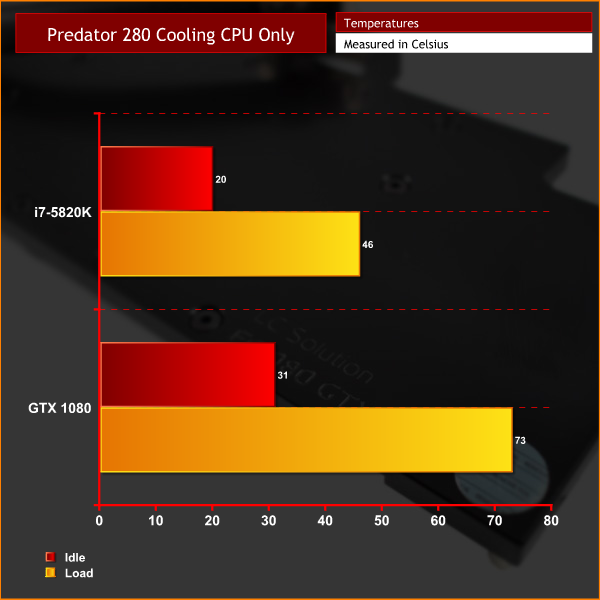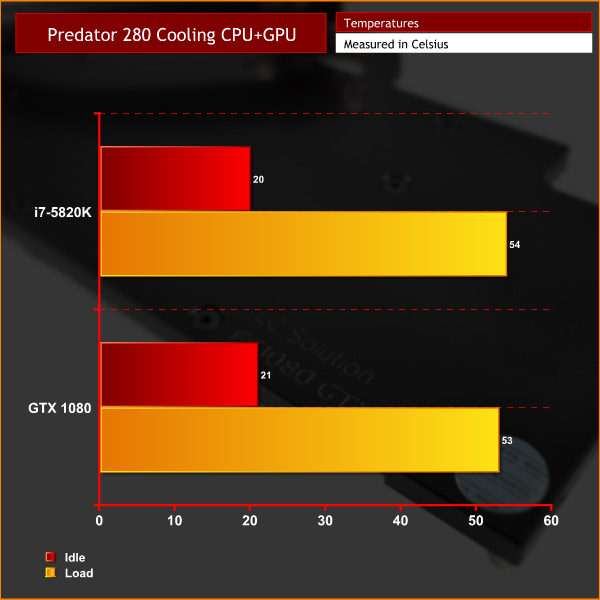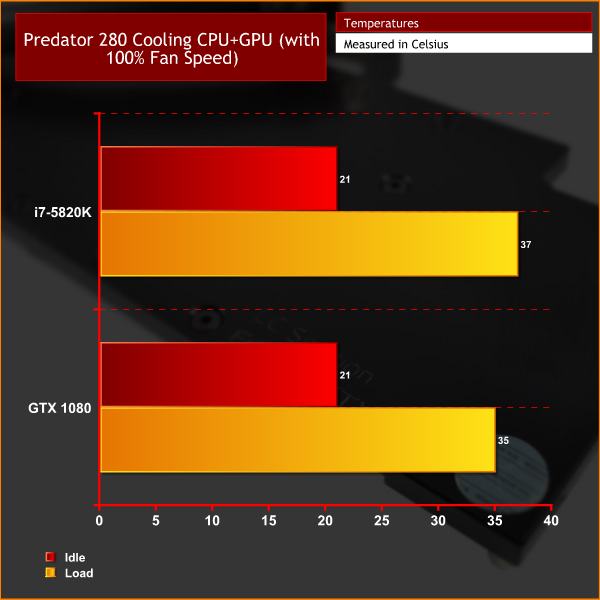First test – the Predator 280 is cooling just the CPU
A peak temperature of 46 degrees is a great result for this i7-5820K – which goes to show the Predator 280 is excellent if you want to use it as a ‘stand-alone' AIO cooler.
The GTX 1080 peaked at 73 degrees using its air cooler – hopefully this should be significantly reduced when we watercool it.
Second test – the Predator 280 is cooling the CPU and the GPU
As you can see, the GPU's temperature dropped by exactly 20 degrees when being cooled by the Predator 280. This is very impressive and should allow further overclocking of the graphics card, resulting in better frame rates.
However, as the 280mm radiator now has to contend with cooling another component, the CPU's temperature rose to 54 degrees – an increase of 8 degrees over the baseline figure from above.
Third test – the Predator 280 is cooling the CPU and GPU, with its fans set to 100%
Before showing you the results of my (unplanned) third test, I will briefly explain why I decided to do another run with the Predator 280.
Essentially, during my testing, I noticed that the Vardar fans on the Predator 280 were spinning quite slowly when controlled via the PWM header on my motherboard – at around 400-450rpm. While this meant the AIO was essentially silent, I thought it may be adversely affecting thermals. So I decided to run one more test with the fans set to 100% – meaning they spin around 1600rpm.
As you can see, increasing the fan speed saw a marked drop in temperatures. A peak temperature reading of 35 degrees for the graphics card is hugely impressive. Granted, neither the CPU or GPU were overclocked for testing today, but the temperatures are still very low.
Noise levels are noticeably worse with the fans running at 100% though – but even then, it is not too bad. A headset would block out the noise, as would some speakers turned to a reasonable volume, for example. When the Predator 280's fans were controlled by the motherboard, however, I could not hear them above the background noise though – so there is space for users to find the right balance between noise and thermals as it suits them.
 KitGuru KitGuru.net – Tech News | Hardware News | Hardware Reviews | IOS | Mobile | Gaming | Graphics Cards
KitGuru KitGuru.net – Tech News | Hardware News | Hardware Reviews | IOS | Mobile | Gaming | Graphics Cards






Interesting cooler.
Can it run completely fanless in idle?
In theory I suppose so. However, at a low rpm the fans are really inaudible so it just feels a bit risky – if your CPU utilisation spikes without you knowing, it could overheat with the fans switched off
I’ve oc my 6800k 4GHz, after 3 hours of Gears of War 4, the maximum temperature was 49C. The Silverstone TD02-E was set at 65%, about 1600 rpm.
I like this design a bit more than the Switftech design for a semi open loop but I do wish the end reservoir was mounted in such a way that if you remove the fans, the front face of the radiator (side where the fans are normally mounted) would be flush with the res, I really would like a cooler like (so I can have some kind of loop) this in my Haf XB but given my graphics card is pretty long (it’s a triple fan Strix), this makes using a Switftech cooler or this cooler impossible unless the res with either unit could be remounted out of the way or was designed so that I can mount the radiator on one side, then the fans on the other side of a panel. Yes, I could go with an actual loop, but these semi open loops allow making one far cheaper, for cooling my graphics card, I just need to add 2 fittings, some tubing and a water block, which worst case would be $365 total